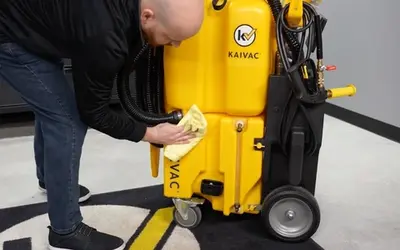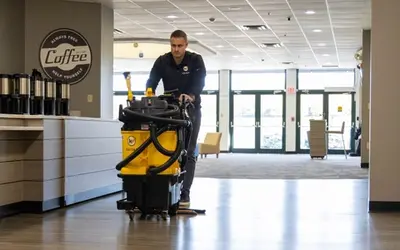How to Boost Grocery Spill Response Time

What’s your grocery store spill response time? The answer could be the difference between a clean, safe environment or a hazardous, costly one. No one expects grocery stores to be spill-free. With rushed shoppers, cranky kids, bulky carts, and plenty of breakable items, accidents happen. But what happens after the spill creates the greatest impact, because people are at risk.
The longer a spill remains on a floor, the greater the risk of a customer or employee slipping and falling. And the danger isn’t limited to spills or broken glass jars. Likewise, leaky equipment, melting snow, or tracked in rain can cause dangerous and potentially expensive slip-and-fall accidents.
Protect your customers, employees, and reputation by responding to grocery store spills quickly and cleaning them completely.
Cost of a Spill
Spills can cost grocery stores in a couple of ways. The obvious ones, lost product and employee work hours, create more of a financial inconvenience than a big-ticket expense. It’s only after someone slips and falls that things start getting serious–and seriously costly.
The National Floor Safety Institute tracks slip-and-fall incidents. They have found that:
- Slips account for over one million hospital emergency room visits
- The most lost work days result from slips and falls
- Slips and falls are the leading cause of workers’ compensation claims
- Compensation and medical costs for employee slip and falls is $70 billion annually
- Defending against slip and fall claims cost an average of $50,000 per incident.
What is a Spill
Spills are not as straightforward as you might guess. Sure, there are the obvious messes, think dropped drinks, broken bottles or smashed jars, but other grocery items, like flour, rice, grains or any small, dry, particulate act like tiny ball bearings and leave your floor a treacherous hazard.
Sometimes liquid accumulates, because equipment is malfunctioning and leaking. Or water from the line of produce misters is pooling on the floor. Ironically, freshly-mopped, wet floors can be as much of a slip hazard as the initial spill. If you think putting out brightly-colored warning signs will protect your customers, think again. Ten percent of accidents are caused by tripping over the Wet Floor sign.
Bad weather can also increase slip and fall incidents. Tracked in rain, snow and ice will leave dangerous puddles of water around the entryways. Melting road salts will damage expensive floor finishes leaving surfaces unsightly and potentially dangerous.
Robots to the Rescue?
To avoid slips and falls, identify and remove a spill as quickly as possible. In an effort to boost spill response time two grocery store chains, GIANT/MARTIN’s and Stop & Shop, deployed nearly 500 autonomous robots to patrol store aisles. The human-sized robot, named Marty, costs a whopping $35,000 and spends its workday looking for spills, debris and other hazards.
And not much else.
‘Essentially, once Marty identifies a hazard using its sensors, it stops in its tracks, changes its signature operating lights from blue to yellow, and repeatedly announces ‘caution, hazard detected,’ in English and Spanish. One of several catches to their existence, however, is that the robots don’t actually clean anything’ writes Nicole Gallucci in a Mashable article.
Response to the program has been mixed. Some shoppers, especially those with kids, seem to love the googly-eyed robot. The rest describe him as creepy, ominous or just plain useless.
Gallucci reports that store employees don’t seem to care for the robot at all, saying ‘it’s really not doing much of anything besides getting in the way. And in some cases, the machines even create more work’.
Cleanup Spills the Right Way
While technology hasn’t delivered a completely automated cleaning robot yet, there are ways to boost grocery spill response time and fully remove slip and fall hazards. Just don’t try to do it by reaching for a mop.
For spill cleanup, mops held the title as the go-to technology for a long time. Unfortunately, they just don’t perform well. Mops can’t fully remove spilled or tracked in liquids and air-drying leaves the floor wet and slippery for a dangerously long time, increasing the risk to people and property. And that Wet Floor sign, well, it’s a tripping hazard too.
Try an AutoVac Stretch™ or the All Floor™ instead. This technology removes the entire spill quickly and completely. Floors are left clean, dry and ready to walk on. The technology is so advanced the National Floor Safety Institute certified it for providing ‘High Traction.’
And unlike Marty the robot, employees actually enjoy working with the easy-to-use technology. These machines reduce cleaning time by 25% or more, leave floors clean and dry and your store is ready for more customers.
Related Posts

Preventive Maintenance for Your No-Touch Cleaning® System
Your Kaivac No-Touch Cleaning system makes restroom maintenance fast and easy. Keeping your No-Touch Cleaning system in good working order is also fast and easy. Kaivac makes performing preventative maintenance and troubleshooting potential issues simple. No special equipment or technical expertise required.
Read more
A System for Every Aisle: How Kaivac Delivers Complete Grocery Store Cleaning Solutions
Kaivac’s integrated Grocery Suite streamlines cleaning across every store zone, cutting labor, reducing cross-contamination, and delivering faster, deeper hygiene results for safer, fresher stores.
Read more
How to Clean Worship Facility Floors
Worship facilities need clean, safe floors to best serve their congregations. Here’s how tools from Kaivac keep worship facilities clean from the entry to seating areas to kitchens and more.
Read more